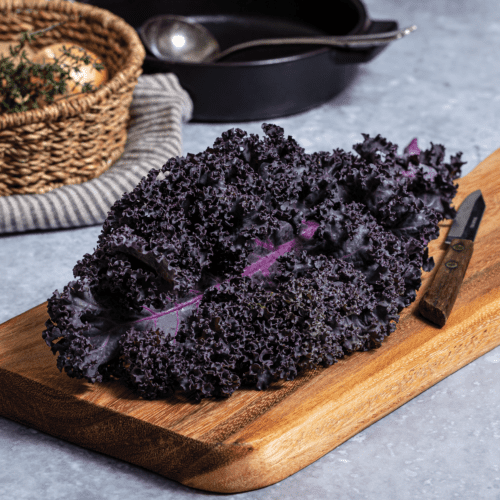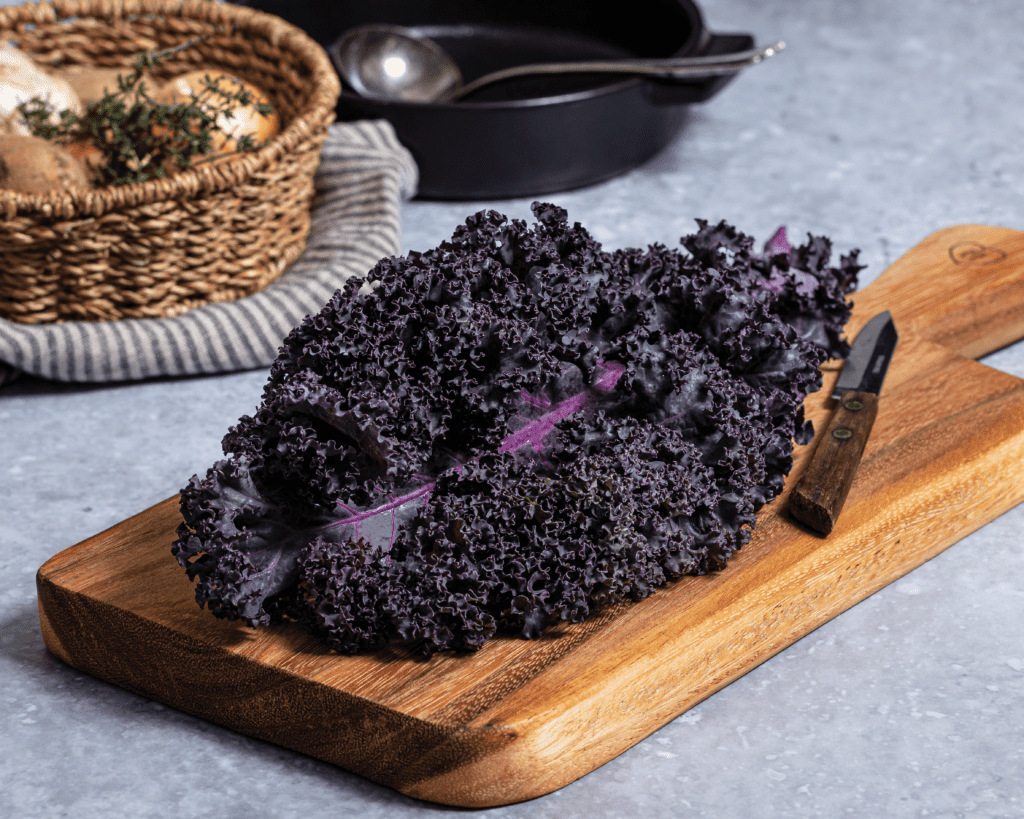The color purple reigns supreme in the world of modern kale. While myriad varieties of purple kale fill salad bowls, sauté pans, and snack bags, most fall into one of three categories: curly, flat, and dinosaur.
The curlies are grown to be seen as well as eaten. The most popular is Redbor, which can grow to be five feet tall. This plant’s mass of serrated, ruffled leaves in variegated green and red are connected by deep purple veins. The combination makes a fetching garden border, one that resists bolting in the heat and is cold-hearty when temperatures turn frosty.
Redbor can be harvested early—young, tender leaves make an intense addition to salads where they hold up to bold flavors like chiles, ginger, toasted nuts, soy sauce, and sesame oil. When cooler weather hits, Redbor leaves turn a solid, deep violet, and their flavor sweetens. Mature leaves are best cooked. They lose some color when heat is applied, but the flavor holds when steamed, braised, fried, sauteed, and baked.
Due to a Redbor seed shortage in 2016, farmers turned to Scarlet kale. It’s shorter and sports a slightly less crinkly leaf, but seed companies still sell Scarlet kale seeds as they are cheaper than Redbor, and their leaves can be used interchangeably in recipes.
Flat and Sweet
The main flat purple kale cultivar—now called Red Russian because it came to North America with Russian traders in the early nineteenth century—has wide, dark green fronds shaped like oversized oak leaves, magenta veins, and deep purple stems.
Due to its interesting shape and color, Red Russian is harvested as microgreens and baby greens. They add a sweet and subtle taste to salads. The leaves, though, are still tender, sweet, and slightly peppery when fully mature. The downside to Red Russian is that it wilts quickly once picked.
Lacinato kale, also called dinosaur kale due to the scale-like texture of its leaves, is the kale most likely to be eaten raw because it is so much less bitter than curly kale. Farmers like lacinato because it grows quickly. Plant breeders, looking to add some variety to the previously deeply dark green lacinato kale scene, crossed it with purple kales to create varieties called Rainbow Lacinato Curly Kale and Dazzling Blue Dinosaur Kale.
Together, the curly, flat, and dinosaur kale varieties make one big, happy family of options for eaters to try.

Purple Kale, Sausage, and White Bean Soup
Ingredients
- 8 cups unsalted chicken stock
- 2 to 3 Parmigiano Reggiano or Grana Padano rinds
- 3 sprigs thyme
- 1 teaspoon black peppercorns
- 2 tablespoons olive oil
- 1 pound bulk sweet Italian sausage
- 1 medium yellow onion coarsely chopped
- 1 large carrot coarsely chopped
- 1 medium russet potato peeled and coarsely chopped
- 3 medium cloves of garlic coarsely chopped
- 1 tablespoon minced fresh rosemary
- 1 15.5 ounce can great northern beans drained and rinsed
- 1 14.5 ounce can diced fire-roasted tomatoes
- 1 bunch purple kale tough stems removed and leaves coarsely chopped (about 4 cups)
- Kosher salt to taste
- Freshly ground black pepper to taste
- Grated Parmigiano Reggiano or Grana Padano for serving
Instructions
- In a small saucepan, combine chicken stock, cheese rinds, thyme, and peppercorns. Place over low heat and simmer for one hour. Strain broth and set aside.
- In a 5- to 6-quart Dutch oven or similar heavy pot, heat oil over medium-high heat. Add sausage and cook, breaking it up, until lightly browned, about 7 minutes. Transfer to a bowl and set aside.
- Add onion, carrot, and potato to pot, lower heat to medium, and cook, stirring occasionally, until vegetables begin to soften, about 5 minutes. Add garlic and rosemary, and cook, stirring, until fragrant, about 30 seconds. Add beans, tomatoes, and reserved broth, bring to a simmer, and cook for 10 minutes, skimming as needed. Add kale and reserved sausage, and simmer for 5 minutes. Season with salt and pepper to taste.
- Serve hot, with cheese sprinkled on top.





